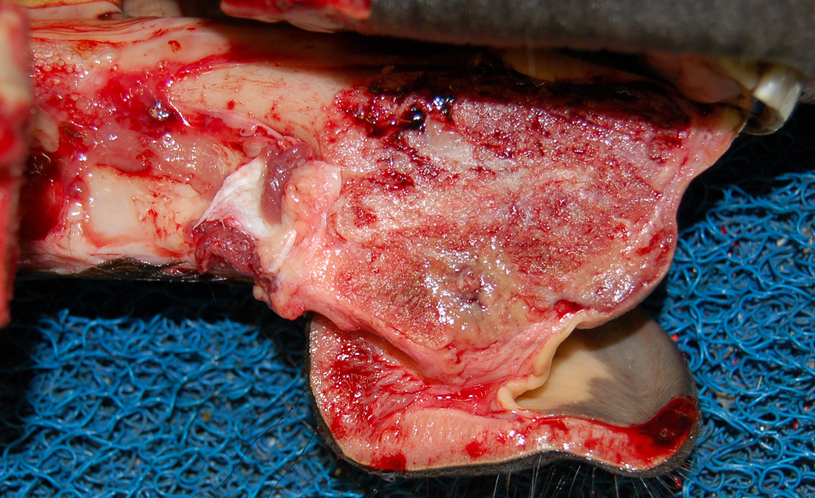HORSES
Equine juvenile ossifying fibromas
Andrew Vince
Multiple deep punch biopsies were submitted to the AHL from a mandibular mass from a 5-month-old Quarter Horse; the mass had first been noted 8 wk prior and had failed to respond to antimicrobial therapy. Radiographs reportedly showed significant reactive and proliferative bone in association with the mass. Histologically, this mass was composed of slender spindle cells arranged in streams and whorls on moderate-to-large quantities of fibrous stroma. The constituent cells had poorly defined cell margins, small-to-moderate quantities of pale eosinophilic cytoplasm, oval-to-elongate nuclei, 3-fold anisokaryosis, finely granular chromatin, innocuous nucleoli, and 4 mitotic figures in ten 400x fields. Scattered throughout the mass were occasional irregular islands of osteoid containing numerous plump spindle cells typical of osteoblasts; some of these were well-differentiated, hypocellular, and mineralized; others were more hypercellular and poorly mineralized. After consultation among AHL pathologists, the consensus was that this lesion was an ossifying fibroma.
Ossifying fibromas are rare tumors of the mandible (and rarely maxilla) of young horses (Fig. 1), rarely reported in cats, dogs, and sheep, and with a similar pathologic entity in children. These masses are firm-to-hard, expansile, and arise from and distort bone. They have histologic features similar to osteomas with a larger contribution of denser fibrous stroma.
These masses are benign and slow-growing with no reported risk of metastasis. However, their location can impact normal prehension of feed and can make them difficult to resect, particularly when very large. Eight similar cases of equine ossifying fibroma were identified in a search of AHL records from 1998-2016, including 2 postmortem cases, 1 excisional biopsy, and 5 incisional biopsies. Of these, 3 were in Thoroughbreds, 2 in Standardbreds, 2 in Quarter Horses, and 1 in a Belgian horse; 5 were in males, 3 in females. The age was specified in 6 of 8 cases; the average was 6.3 years, with a minimum of 3 months and a maximum of 12 months. Seven of 8 were within the mandible, 1 in the maxilla.
Ossifying fibroma should be considered a differential diagnosis in young horses with progressively expanding masses on the mandibles or maxilla. Larger, deeper biopsies are often required for definitive diagnosis. AHL

Figure 1. Juvenile ossifying fibroma in the rostral mandible of a young horse.
ACTH seasonality and PPID
Felipe Reggeti
Pituitary pars intermedia dysfunction (PPID; “Cushing’s disease”) is an endocrine condition commonly identified in aging horses and ponies. It is considered to result from loss of dopaminergic inhibition of the pituitary gland causing excessive release of ACTH into plasma and subsequent hypercortisolemia. The diagnosis may be based on clinical signs in “full-blown” cases, but it is often more difficult in animals with subtle signs or inconclusive laboratory data.
Multiple endocrinology tests have been proposed to support a diagnosis of PPID, but in 2015, the Equine Endocrinology Group (http://sites.tufts.edu/equineendogroup) recommended the use of endogenous ACTH and the TRH-stimulation test measuring endogenous ACTH (availability of TRH is currently limited in Canada). The AHL offers a chemiluminescent ACTH test, individually and within various endocrine profiles, but results must be interpreted in the context of clinical presentation and the time of the year the test was performed. The latter is of consideration because a “seasonal rise” in ACTH has been documented during the fall months, with median concentrations ~2 times the upper reference limit (although some healthy horses showed significantly higher values). This seasonal increase has an impact in the interpretation of laboratory results. Reference intervals at the AHL (2-10 pmol/L) were developed outside the seasonal rise; thus, as an example, an ACTH result of 18 pmol/L could be adequate in the fall but would be elevated the rest of the year.
The seasonal rise in ACTH may be exaggerated in early PPID, increasing the sensitivity of the test; however, elevated ACTH may be associated with other stress-related conditions and does not necessarily imply that the animal will develop PPID. Further, some of the clinical and laboratory findings of PPID overlap with other endocrine conditions, including equine metabolic syndrome (e.g., laminitis and insulin dysregulation with or without hyperglycemia), making the diagnostic interpretation challenging. AHL




